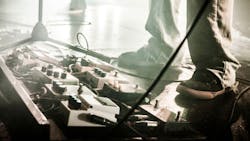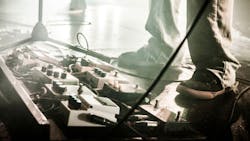I was sitting in Greune Hall, the oldest (1854) dance hall in Texas drinking a cold Lone Star longneck and contemplating what music would be like without electronics. It was 101 degrees outside and the twelve ceiling fans were just barely keeping up with the heat in this ancient wooden building. Most famous country music stars have played here at one time or another along with hundreds maybe thousands of not-so-famous local bands. It is the kind of place that bikers favor but also one where you can bring the kids if you want. Today I have seen all ages from 4 to probably near 80 walking around or dancing. You can still get a cold beer here for only $2.50 and there is no smoking.
My wife and I were watching a Cajun band tear down and pack their equipment. We speculated that most small bands probably spent more time actually setting up and tearing down their gear than they ever did performing. Besides the guitars, keyboards, drums, and other instruments there are lots of electronic pieces like speakers, microphones, amplifiers, mixers, percussion effects, monitors and cables. Always lots of cables. It is a major process to pack, unpack, set up and tear down each time you perform but you can’t not do it. The electronics has become the backbone of the music business.
We watched the Cajun band drive away in a 1970s era travel van. Then one beer later, we watched another local band set up. It took just about an hour and several beers for them to unload, place, connect and test their set up. And then they began to play. After three sets and lots of audience dancing and more beers later, the band reversed the ritual and started tearing down and repacking making space for the next band. That is what I am calling electronic music hell. And it is universal and affects small bands as well as the big stars with their major sets, sound systems, light shows and special effects. Big stars travel with multiple 18-wheelers to haul the stage gear. Set up and teardown is hell for the full time roadies that do the grueling work.
But can you imagine music without the electronics? Big amps and speakers are a major part of any music venue. Furthermore you need a major mixing console to blend all the mikes and instruments into the unique sounds of the performers. Today light shows are a huge part of the show. Multicolor lights, flashing lights, spots and rotating lights plus lasers are common. Think of all the computers, programming , and electronics involved in that process. In addition, most shows also feature one or more monster HD video screens so fans far away from the action can see what is going on. No electronics, no show.
The electronics for music concerts has become a big business. With CD sales way down and streaming music growing, big stars and bands are relying more today on touring for major income. And that means lots of electronic gear. Banks of big speakers, multimillion dollar computer-controlled light shows and huge video screens. It is a multi-billion dollar industry that keeps the likes of Katy Perry and Lady Gaga supplied with all the special effects their acts demand to keep them competitive and the fans coming back for more. Dozens of companies like Clair Brothers and Tait Towers serve this need. Most of them are clustered in the unlikely Amish country town of Lititz, PA. Recently the industry built a 52,000 square foot rehearsal building in Lititz where stars can set up, tweak and test their stages in secret. It is electronic heaven to the stars that increasingly rely on fancy effects in addition to their musical talent. But it is electronic hell for those who transport, build, test, operate and tear down such gear. Thank goodness for cold beer.
About the Author

Lou Frenzel Blog
Communications Technology
Click here to find more of Lou's articles on Electronic Design.

